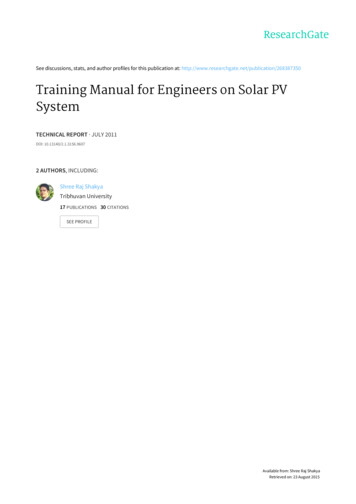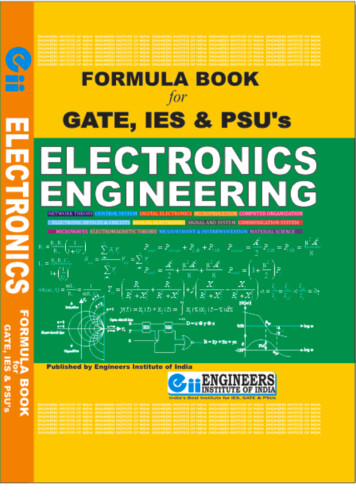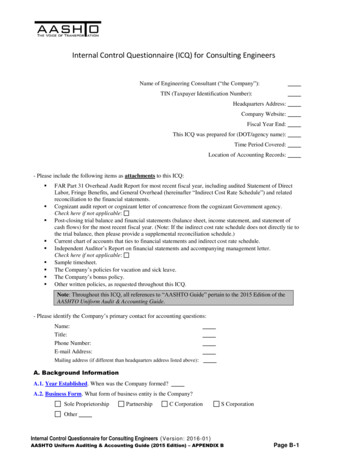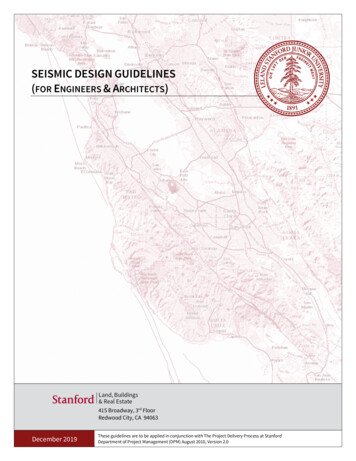
Transcription
See discussions, stats, and author profiles for this publication at: raining Manual for Engineers on Solar PVSystemTECHNICAL REPORT · JULY 2011DOI: 10.13140/2.1.3156.96072 AUTHORS, INCLUDING:Shree Raj ShakyaTribhuvan University17 PUBLICATIONS 30 CITATIONSSEE PROFILEAvailable from: Shree Raj ShakyaRetrieved on: 23 August 2015
ALTERNATIVE ENERGY PROMOTION CENTRE(AEPC)ENERGY SECTOR ASSISTANCE PROGRAMME(ESAP)Training Manual For Engineers onSolar PV SystemJuly 2011
Government of NepalMinistry of Environment, Science and TechnologyAlternative Energy Promotion Center (AEPC)Energy Sector Assistance Programme (ESAP)Khumaltar Height, LalitpurP.O. Box: 14237, Kathmandu, NepalTel: 977-1-5539390, 5543044, 5539391. Fax: 977-1-5539392Email: ssp@aepc.gov.npWeb site: www.aepcnepal.orgCoordinated byRam Prasad Dhital, Sr. Energy OfficerMadhusudhan Adhikari, Solar Energy Component ManagerTeam of authorsProf. Dinesh Kumar Sharma, Dr.Team leader and PV ExpertEr. Shree Raj Shakya,Energy ExpertEditing Team:Mr. Mukesh GhimireMr. Chaitanya P ChaudharyEnergy Officer AEPCProgram Officer AEPC/ESAP
PrefaceThe Alternative Energy Promotion Centre (AEPC) was established in 1996 as an apexgovernment body to promote the use of renewable energy technologies to meetenergy needs in rural areas of Nepal. With successful completion of the first phase ofthe Energy Sector Assistance Programme (ESAP), AEPC has initiated second phaseof the programme from March 2007 with support from Government of Denmark andthe Government of Norway. The support to solar energy is one among the differentprogramme components.Working for promotion of the PV technology among the rural population out ofaccess to electricity, ESAP has been carrying out different trainings for capacitybuilding of partner organizations. As a training tool to use in Solar Design Engineers’training, a manual has been developed with effort from experts and other concerned.This volume of Training Manual for Engineers on Solar PV System consist oftechnical details required for feasibility study, designing and implementation ofinstitutional Solar Photovoltaic systems. The manual is with adequate informationand guidelines to be used in training for engineers working in solar PV or withinterest to work in the sector.Authors’ team of PV expert, Prof. Dr. Dinesh Kumar Sharma and energy expert,Engineer Shree Raja Shakya has put their significant effort for preparing this manual.I would like to acknowledge their effort in this endeavour.I would like to thank SSP manager Mr. Madhusudhan Adhikari and Sr. Energy officerRam Pd Dhital for support while preparing this manual and would like to thankAEPC Energy officer Mr.Mukesh Ghimire, SSP programmer officer Mr. Chaitanya PChaudhary for their support in this attempt.I further would like to acknowledge the support of all responding institution andindividuals who provided the valuable information to complete this manual.Dr. Narayan Prasad ChaulagainExecutive DirectorAlternative Energy Promotion Centre (AEPC)
Table of ContentsTraining Manual for Engineers on Solar PV System – At a GlanceTraining Schedule1.Skill Standards of CTEVT, Skill Testing/ Certification procedures12.Features and requirements for Skill Standard tests and certificationprocedures for solar photovoltaic Design Engineer and Technicians33.History of development of solar photovoltaic technology in Nepal54.Basics of Electrical Engineering4.1Electrical Power Supply System4.2Solar Photovoltaic Technology1112175.Fundamentals of solar photovoltaic technology5.1Basic Principles of Photo-Voltaic Effect5.2Solar Cells5.3Solar Modules5.4Solar Array27283343516.Components of a solar photovoltaic system6.1Batteries6.2Charge Controllers6.3Lamps and Other Loads6.4DC-AC Inverters6.5DC-DC Converters6.6Wiring and installation practices575873808690927.Solar home system (SHS) design and installation7.1Design of Solar Home System (SHS)7.2Installation of Solar Module7.3Installation of Charge Controller7.4Installation of Battery7.5Wiring of the solar home system components7.6Lamp installation procedures7.7Switch installation procedures7.8Power socket installation procedures7.9Components assembly of Solar Home System7.10 Installation of solar home system components95971061091101101151171181191238.Repair and maintenance of components of solar photovoltaic systems8.1Solar Module8.2Battery8.3Charge Controller8.4Solar Lamp8.5DC-AC Inverter8.6DC-DC Converter125127127131141144144
8.79.Demonstration of various components, their testing and repairingprocedures145Design aspects of large solar photovoltaic systems(non-pumping applications)9.1Load calculations9.2Sizing of Module /Array9.3Sizing of Storage Battery9.4Sizing of Charge Controller9.5Sizing of Wire/ Cable9.6Sizing of Inverter9.7Sizing of DC-DC Converter9.8Installation Procedures, Safety and Protection14915115615916116316516716810.Design aspects of water pumping systems10.1 Introduction10.2 Water Pumping System Configurations10.3 Water Pumps10.4 Motors10.5 Integrated Pump/Motor Machines10.6 Power Conditioning Circuitry10.7 Array Wiring and Mounting of Water Pumps10.8 Water Pumping System Design10.9 Installation Line Diagrams10.10 Routine and Preventive Maintenance10.11 Monitoring and Evaluation of Installed Water Pumps18919119319419820020320420521421721811.Socio – techno Economic Feasibility Study11.1 Introduction11.2 Basic Principles of Feasibility Study11.3 Technical Aspects of Feasibility Study11.4 Energy Demand Analysis11.5 Financial Analysis11.6 Sensitivity Analysis11.7 Repayment Schedule11.8 Cash Flow Analysis11.9 Tables and Formula for Quick Reference11.10 Suggested Format for Feasibility chnical GlossaryAppendices:1.Nepal Interim PV Quality Assurance2.Format for Feasibility Study of ISPS3.Solar Radiation in Different Parts of Nepal4.Technical Catalogues of Various Solar PV Components
Training manual for Engineers on Solar PV System1.Objective: To provide training to the Engineers capable of working andwilling to work on Solar Photovoltaic Systems.2.Duration: 8 days (49 hours) 1 day Field Visit3.Minimum Qualification of trainee: Bachelor’s degree in Engineering.4.Minimum Qualification of trainer: Engineers or PV experts with goodexperience in design and installation of Solar Photovoltaic Systems.5.Reference materials:a) Solar Photovoltaic System Design Manual for Solar Design Engineers,AEPC/ESAPb) Solar Electricity Technical Training Manual (Level 1), AEPC/ESAP.c) Solar Electricity Technical Training Manual (Level 2), AEPC/ESAP.d) Training manual for training of Solar technician trainers6.Suggested course outline:i. Skill standards of CTEVT and skill testing/ certification procedure.ii. Features requirements of certification procedure for Solar PV Technicianlevel-1.iii. Features requirements of certification procedure for Solar PV Technicianlevel-2.iv. History and development of solar photovoltaic in Nepal featuring history,installed capacity, users and promoting institutions, donors, future plans andprograms.v. Basic of electrical engineering theory.vi. Components of solar PV systemsa) Solar cell, module, arrayb) Storage batteriesc) Charge regulatorsd) Inverters and converterse) Wiring and installation practicesvii. Solar home system (SHS) design and installationa) Components of SHSb) Installation norms and practices of SHSc) Basic design of SHSviii. Repair and maintenance of components of solar PV systemsa) Modules / arrays
b)c)d)e)DC ballastCharge controllersBatteriesDC converters and invertersix. Design aspects of large (institutional) PV systems – non pumping applicationsa) Load calculationb) Sizing of module/ arrayc) Sizing of storage batteryd) Sizing of wires and cablese) Installation procedures/ safety and protectionx. Design aspects of water pumping schemesf) Load calculationg) Sizing of module/ arrayh) Sizing of storage batteryi) Sizing of wires and cablesj) Installation procedures/ safety and protectionk) Socio-techno economic feasibility study of large solar photovoltaicsystems.Training ScheduleSessionIDay 11&2Day 25.3 &5.4II3&Part of4.16.1IIIPart of4.1, 4.2& 5.16.2IVPart of5.1 &5.26.3 &6.4Day 3Part of6.5,6.6 &7.1Part of7.1Day 47.4, 7.5& 7.6Day 5Part of8.1, 8.2& 8.3Day 69.1, 9.2& 9.3Day 710.1,10.2 &10.37.7, 7.8& 7.9Part of8.3, 8.4& 8.59.4 &9.5Part of7.17.10Part of8.6 &8.7Part of9.6, 9.7& 9.810.4,10.5,10.6 &10.710.8Part of7.1, 7.2& 7.37.10Part of8.7Part of9.810.8Day 8Part of11.1 11.4 &11.5Part of11.5Part of11.5,11.6,11.7 &11.8Part of11.8,11.9 &11.10The duration of each session will be 90 minutes. There will be 15 minutes breakbetween the sessions.Field visit should be conducted after the completion of chapter 10.
7.Fraunhofer-Institute fur Solar Energiessysteme (FhG-ISE), PhotovoltaicSystems, March, 1995Solar Photovoltaic System Design Manual for Solar Design Engineers,Alternative Energy Promotion Center (AEPC)/ Energy Sector AssistanceProgramme (ESAP), 2003Solar Electricity Technical Training Manual (Level 1), Alternative EnergyPromotion Center (AEPC)/ Energy Sector Assistance Programme (ESAP),2006Solar Electricity Technical Training Manual (Level 2), Alternative EnergyPromotion Center (AEPC)/ Energy Sector Assistance Programme (ESAP),2006Martin A. Green, Solar Cells, The University of New South Wales,Kensington, Australia, February, 1992L. Stamenic; G. Ingham, Solar Photovoltaic Revolution, United powerLimited, Canada, 1995J. Schaeffer et.al. , Solar Living Source Book, Chelsea Green PublishingCompany, Vermont, 1994J.N.Shrestha, Photovoltaic Technology-Course Manual, Institute ofEngineering, Tribhuvan University, 1999Training Manual for Solar Electric Technician (Level-2), AlternativeEnergy Promotion Center (AEPC)/ Energy Sector Assistance Programme(ESAP), 2001Vervaart M.R.; Nieuwenhout F.D.J, Manual for the Design andModification of Solar Home System Components, IBRD/ The WorldBank, USA, 2001Status of Solar Photovoltaic Sector in Nepal, Alternative EnergyPromotion Center (AEPC)/ Energy Sector Assistance Programme (ESAP),2003Schaeffer J., Alternative Energy Source Book, 7-th edition, 1992.Joshi A.R., et.al., Environmental Management and SustainableDevelopment at the Crossroad, 2003.CADEC, 2003. Renewable Energy: Data of Nepal, Community AwarenessDevelopment Center, Kathmandu, Nepal.Piya R., Study on Quality Interventions, Product Quality and SystemPerformance of Solar Home System in the Market of Nepal(Casestudy of Solar Energy Support Programme (SSP) of AEPC/ESAP),2006www.pvpower.comwww.pvresources.com
Chapter 1Skill Standards, Testing/ Certification ProceduresCHAPTER 1Skill Standards of CTEVT, Skill Testing/ Certification ProceduresDuration:90 minutesPhysical Facilities required: Class room with white board and multi-media projectionfacility.Materials required: Brochures of Skill Testing Division (STD) of CTEVTProcedures:1. Instructor explains the composition of CTEVT, its aims and objectives.2. Instructor explains the functions of Skill Testing Division of CTEVT processesinvolved in skill certification.3. Q & A session, ExamplesInstructor: Invited guest speaker from CTEVT – STDReference:1. Skill Standards for Solar Technicians Level 1 and Level 22. Rules and Regulations of CTEVT – STDLesson PlanSubLesson detailschapter1Skill Standards ofCTEVT, SkillTesting/ FacilitiesrequiredClass roomDuration Remarks90 mins.
Chapter 2Features and Requirements for Skill Tests and CertificationCHAPTER 2Features and requirements for Skill Standard Tests and Certificationprocedures for solar photovoltaic Design Engineer and TechniciansDuration:90 minutesMaterials required:a) Solar Technicians Level 1 and Level 2 Skill Standardsb) CTEVT documents on Skill Certification for Solar PV Technicians Level 1 andLevel 2c) Solar photovoltaic Design Engineer requirementsProcedures: The instructor/s explaina) Objective of Solar photovoltaic Design Engineer Certificateb) Objective of Solar PV Technicians Level 1 and Level 2 Certificatec) Processes involved in Skill Testingd) Certification procedurese) Q & A sessionInstructor:a) Invited guest speaker from CTEVTb) The TrainerReference:1. Skill Standards for Solar Technicians Level 1 and Level 2Lesson PlanSubLesson detailsTeachingchapterMethodology2Features andLecturerequirements for SkillStandard Tests andCertificationprocedures for Solarphotovoltaic DesignEngineer and SolarTechnicians Level 1and Level 23FacilitiesrequiredClass roomDuration Remarks90 mins.
Chapter 3History and development of solar PV technologyCHAPTER 3History of Development of Solar Photovoltaic in NepalDuration:45 minutesPhysical Facilities required: Class room with white board and multi-media projectionfacility.Materials required: Reference materialsProcedures: The instructor/sa) explains the development stage of Solar PV in Nepalb) provides updated statistics of use of Solar PV in Nepalc) elaborates on the roles/ responsibilities of various agencies involved in thepromotion of solar PV in Nepal (AEPC, ESAP, REP, CTEVT, CRE, CES, KU,etc.)Instructor: The TrainerReference:1. Solar Photovoltaic System Design Manual for Solar Design Engineers,AEPC/ESAP2. Solar Photovoltaic Data Book, AEPC/ESAP3. Brochures of various institutesLesson PlanSubchapterLesson on3History ofdevelopment of SolarcellsLectureClass room45 mins.5Remarks
History and development of solar PV technologyChapter 3Solar EnergyThe energy from the sun can be exploited directly in the form of heat or first convertedinto electrical energy and then utilized. Accordingly the solar energy is classified intosolar thermal and solar photovoltaics (PV).Solar thermal has numerous applications like water heating, drying vegetables andagricultural products, cooking etc. In Nepal the solar water heaters are being extensivelyused in urban areas. The applications of solar dryers and cookers have found moderateuse simply because of the low level of dissemination of these technologies.The solar PV, on the other hand, is extensively used not only in the developing countriesbut also in highly developed countries. The application of solar PV is virtually unlimited.Countries like Germany, Japan and United States of America have initiated highlysubsidized rooftop programs for solar PV. The level of subsidy is up to 65% of the totalsystem cost. In Nepal solar PV is extensively used for communications, home lighting,drinking water pumping etc. The installed capacity of Solar PV in Nepal now exceeds 3.4MWp mark and over 93,000 households are electrified using this technology.Considering the positive impact that solar PV can bring to the rural population of thedeveloping countries like Nepal, the Government of Kingdom of Denmark has supportedEnergy Sector Assistance Program (ESAP) to promote alternative energy sources,including PV. ESAP target was to subsidize installation of 25,000 Solar Home Systemswithin a time span of 5 years. Similarly, a sizeable project with assistance from EuropeanUnion (EU) is being implemented to promote institutional Solar PV in Nepal.The solar PV can be considered the only form of electricity that can be generated anytime and anywhere provided sunshine is available. The earth receives more energy fromthe sun in just one hour than the world uses in a whole year. The annual total amount ofsolar energy incident on the surface of the earth is estimated to be about 795 x 1012 MWh,which is 8300 times greater than the global energy demand in 1991. The Environmentalsavings from the Photovoltaic modules are highlighted in table 3.1 below:Table 3.1 Environmental Savings from Photovoltaic ModulesDescriptionElectricity saved per yearElectricity saved per life of PV moduleBarrels of oil saved over lifetime of PV modulePounds of coal saved over lifetime of PV moduleCarbon Di-oxide kept out of the air over life of PVSulfur Di-oxide kept out of air over life of PV* Based on:Coal required to produce 1 kWh 1 lbCarbon Di-oxide emission 1.5 lb/kWh6Savings of one 50Wp module *90 kWh2700 kWh4.8 barrels2700 lbs4000 lbs23.3 lbs
Chapter 3History and development of solar PV technologyPhotovoltaic (PV) TechnologyPhotovoltaic (PV) Technology is a process of generating electrical energy from theenergy of solar radiation. The principle of conversion of solar energy into electricalenergy is based on the effect called photovoltaic effect. The smallest part of the devicethat converts solar energy into electrical energy is called solar cell. Solar cells are in factlarge area semiconductor diodes, which are made by combining silicon material withdifferent impurities. The sand, a base material for semiconductor, is the most abundantlyavailable raw material in the world. The ordinary sand (SiO2) is the raw form of silicone.The solar energy can be considered as a bunch of light particles called photons. Atincidence of photon stream onto solar cell the electrons are released and become free. Thenewly freed electrons with higher energy level become source of electrical energy. Oncethese electrons pass through the load, they release the additional energy gained duringcollision and fall into their original atomic position ready for next cycle of electricitygeneration. This process of releasing free electrons (generation) and then falling intooriginal atomic position (recombination) is a continuous process as long as there is thestream of photons (solar energy) falling onto the solar cell surface.History of Development of PV TechnologyThe birth of PV technology dates back to 1839 AD when Edmund Becquerel, the Frenchexperimental physicist, discovered the photovoltaic effect while experimenting with anelectrolytic cell made up of two metal electrodes placed in an electricity conductingsolution—generation increased when exposed to light.In 1876 William Adams and R. Day discovered that the junction of selenium andplatinum also exhibit photovoltaic effect. This discovery led the foundation for the firstselenium solar cell construction in 1877.The photovoltaic effect remained theoretically unexplained until the great scientist AlbertEinstein described this phenomenon in 1904 along with a paper on his theory ofrelativity. For his theoretical explanation of photo-electric effect, Albert Einstein wasawarded a Nobel Prize in 1921.Another breakthrough in development of PV technology was the discovery of the methodfor monocrystalline silicon production by Polish scientist Czohralski in 1918. Thisdiscovery enabled monocrystalline silicon solar cells production. The first siliconmonocrystalline solar cell was constructed only in 1941.In May 1954 The Bell Laboratories of USA (Researchers D. Chapin, C. Fuller and G.Pearson) published the results of discovery of 4.5% efficient silicon solar cells.First commercial photovoltaic product with 2% efficiency was introduced in 1955 byHoffman Electronics-Semiconductor Division. The cost of a 14 milli Watt peak power7
History and development of solar PV technologyChapter 3solar cell was US 25 (or US 1,785 per Watt). The efficiency of commercially availablesolar cell increased to 9% in 1958.The first PV powered artificial satellite of the earth, Vanguard I, with 0.1 W of solar celloccupying an area of approximately 100 cm2 and powering a 5 mW back-up transmitterwas launched in 17 March 1958. Three more PV powered satellites were launched in thesame year. The first PV powered telephone repeater also was built in Americus, Georgia,USA in the same year.Sharp Corporation was the first company to develop the first usable PV module (group ofsolar cells put together in a single module) in 1963.By 1974 the cost of PV power came down to US 30 per watt from US 1785 per watt in1955. With the dramatic reduction in the cost, the PV power once affordable only inspace vehicle became an alternative source of electrical energy for terrestrial applications.The fig. 3.1 below illustrates the decrease in price (US per peak watt) of solar PV withtime.dollarPrice in US Watt peak powerFig. 3.1 Average selling price trend of PV modulesAs the price started falling down the demand and production of the PV modules startedgrowing. In 1980 ARCO Solar became the first manufacturer to produce PV moduleswith peak power of over 1 Mega Watt (MW). By 1983 worldwide production of PVmodules exceeded 21.3 MW with a business volume of 250 million US . The totalinstalled capacity of PV modules exceeded 1000 MW worldwide in 1999. As of end of2002, total installed capacity of PV power exceeds 2000 MW and a business volume ofabout 2 billion US (400 MW @ 5 /Wp).8
Chapter 3History and development of solar PV technology350016,00014,000Number of Installations12,00010,0008,000Cumulative Installedcapacity 19 393/919 494/919 595/919 696/919 797/919 898/919 999/020 000/020 101/020 202/020 303/020 404/020 505/06Dec-06Yearly SHS Installation20,00018,000Figure 3.2: Installation of SHSs - Installed till December 2006The estimated market potential is huge and about 4,750 kWp of photovoltaic power iscurrently being used in various public and private sectors (telecommunication, utilitysupply, stand-alone, water supply, aviation etc.) in Nepal are shown in Table 3.2.Table 3.2: Application of PV Power by SectorS.N.ServicePV Power, kWp No. of Installation1Telecommunications10013,000 2Utility supply (centralised)10023Stand-alone system341493,000 4Water supply120515Aviation37456Miscellaneous78100 Total4,750In near future more and more PV systems will be used for various types of services.There is a plan to install 150,000 solar home systems in areas where national grid will notreach within second phase of ESAP (March 15 2007 – March 15 2012. These factsindicate that time has come to pay special attention for PV powered systems for incomegenerating activities.9Cumulative Installed Capacity (kWp)Nepal could not remain in isolation with development pace of PV technology. With only8 Solar Home System (SHS) installations in 1992/93, it increased to over 93,362 SHS byend of 2006. The fig. 3.2 below highlights the trends in growth of SHS installations inNepal which constitute above 3414 kWp as of December, 2006. The trend of SHSinstallation shows a steep rise after 2000 due to the subsidy policy implemented byAEPC/ESAP. Till December 2004, 51 solar PV pumping systems have been installed, ofwhich 28 were installed after 2000 with subsidy provided from AEPC.
History and development of solar PV technologyChapter 3Institutions involved in the promotion of solar photovoltaic technology in NepalVarious institutions are involved in the development and promotion of solar PVtechnology. Bank and Financial Institutions like Agriculture Development Bank/Nepal(ADB/N) and local commercial banks have been playing an active role in rural energyprogram by financing stand-alone SHS . Non Government Organizations like Center forSelf-help Development (CSD), Center for Renewable Energy (CRE), Nepal Solar EnergySociety (NSES), have been successfully involved in limited banking activities andmobilizing donor assistance for the promotion, development and dissemination of SHS.Donor agencies like DANIDA/ESAP, USAID, SNV/Nepal, KfW, UNDP, UNICEF,NORAD, European Union etc. have been contributing by providing financial support inthe form of grant-aid and soft loan. Manufacturer/Installers are manufacturing variouscomponents of SHS and providing quality service. Government Institutions like NationalPlanning Commission (NPC), the Ministry of Environment Science and technology(MOEST), the Water and Energy Commission Secretariat (WECS) of the Ministry ofWater Resources, the Ministry of Finance, etc., have influenced the RETs development’spolicies and programmes.Applied R & D and Human Resource Development Centre/Institutions such as NAST,NARC, RECAST, CES/IOE, KU etc., are involved in different levels of applied R & Dactivities. Institutes like CES/IOE, CTEVT are involved in human resources developmentat different levels for the successful planning, designing, installation, operation andmaintenance of RET projects.RETSIn order to assure the quality of the components to be used in SHS, AEPC/ESAP hasprepared and successfully implemented a standard named, Nepal Interim PhotovoltaicQuality Assurance (NIPQA). In order to check and verify technical parameters of SHScomponents a special laboratory named as Renewable Energy Test Station (RETS) is setup and functional.Renewable Energy Testing Station (RETS) under NAST has started to certify the variousSHS components for quality assurance. An independent body like Nepal Bureau ofStandard and Metrology (NBSM), can play a very important role in controlling thequality of the components/devices/systems of the SHS so that healthy competition amongthe suppliers can be initiated and quality assurance can be guaranteed to the users.10
Chapter 4Basics of Electrical EngineeringCHAPTER 4Basics of Electrical Engineering120 minutesDuration:Physical Facilities required: Class room with white board and multi-media projectionfacility.Materials required: Reference materialsProcedures: The instructor/sa) explains the basics of electrical power systemb) provides basic knowledge on the solar radiationInstructor: The TrainerReference:1. Solar Photovoltaic System Design Manual for Solar Design Engineers,AEPC/ESAP2. Solar Electricity Technical Training Manual (Level 1), AEPC/ESAP.Lesson PlanSubchapterLesson on4.1Electrical PowerSupply SystemSolar PhotovoltaicTechnologyLectureClass room60 mins.LectureClass room60 mins4.211Remarks
Basics of Electrical Engineering4.1Chapter 4Electrical Power Supply SystemsElectrical energy is a very convenient form of energy, which can be easily generated,transmitted, stored and used. Any other form of energy can be easily converted intoelectrical energy. An example of this is solar electricity in which the energy from the sun(solar radiation) is converted into electrical energy by solar cells. Electricity is the branchof science that studies the theory and practices of electrical energy. Electrical engineeringon the other hand is a branch of engineering that deals with generation, transmission,distribution and use of electrical energy.Electrical energy is transmitted from one point to another by means of charged particlescalled electrons. There are three fundamental terminologies used in electricity: Voltage,Current and Resistance.VoltageVoltage or the potential difference is a force that compels the electrons to move from onepoint to another in predetermined manner. In water supply system analogy, the voltagecan be compared with the pressure of water in the storage tank that forces the water toflow in the pipeline. The unit of measurement of the voltage is Volt and is abbreviatedand symbolically represented as ‘V’.CurrentCurrent is the quantity of charged particles flowing in given direction per unit time. Thecurrent can be compared with the amount of water flowing in the pipeline per unit time.The unit of measurement of electrical current is Ampere and is abbreviated as ‘A’.Symbolically the letter "I" represents the current.ResistanceResistance is the property of the material to oppose the flow of current through it. Theunit of resistance is Ohms and abbreviated as ‘Ω’. Symbolically the letter 'R' representsthe resistance.The electrical law that relates the above three fundamental parameters is called Ohm’slaw. According to this law, assuming that all other parameters remain constant, thecurrent through an electrical circuit is directly proportional to the applied voltage andinversely proportional to the resistance of the circuit:I VV(4.1.1)I II RR12
Chapter 4Basics of Electrical EngineeringThe electric current is further classified into direct current (DC) and alternating current(AC). The current is called DC if the direction of flow of current does not change withtime. It means the DC current always flows in one direction only. The voltage that causesthe flow of DC current is referred to as DC voltage. Examples of DC voltages are theoutput voltages of storage batteries, DC generators etc.If the direction of flow of current changes periodically with time then such current iscalled AC current. And the voltage causing the flow of AC current is called AC voltage.Examples of AC voltages are the city supply, output of AC generator etc. The rate orfrequency at which the direction of current changes is termed as cycle per second orHertz (Hz). In one cycle the current changes its direction of flow. In Nepal the frequencyof AC voltage is 50 cycles per second or 50 Hz.The other terminologies used in electrical supply systems are power, energy, active load,reactive load, power factor, crest factor, harmonics and Loss of Load (LoL) probability.Power and EnergyElectrical power may be defined as the energy delivered by the electrical source(generator) to the load (acceptor) per unit time-P Et(4.1.2)where P is the power in Watts (W), E is the energy in Joules (J) and t is the time inseconds.If the supply system is DC, then the power can be expressed as the product of voltage andcurrent, i.e.P V I V2 I2 RR(4.1.3)Re-writing the formula (4.1.2), we can define the energy as product of the power andtimeE P t(4.1.4)Thus the energy can be defined as the power delivered to the load in given duration oftime. In electrical terms the energy is expressed in Watt- Hours (Wh)13
Basics of Electrical EngineeringChapter 4Active and Reactive loadsDepending upon the characteristics of the load it can be subdivided into active andreactive types. This classification of load type is more pertinent to AC supply than DCsupply. If the load is active (i.e. it does not contain any reactive elements like inductanceand capacitance) then the current through the
1. Fraunhofer-Institute fur Solar Energiessysteme (FhG-ISE), Photovoltaic Systems, March, 1995 2. Solar Photovoltaic System Design Manual for Solar Design Engineers, Alternative Energy Promotion Center (AEPC)/ Energy Sector Assistance Programme (ESAP), 2003 3. Solar Electricit










